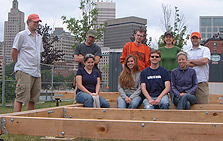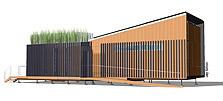

The RISD team looks forward to applying its "very cool" ideas to commercial housing.

A rooftop garden adds a touch of nature to the high-tech features of RISD's urban dwelling.
Solar Decathlon 2005
Rhode Island School of Design
Loft-Like and Very Cool
After Ryan Hammerschmidt presented his team's Solar Decathlon design to a Rhode Island community group, one woman in the audience told him, "Well, it's very impressive, but it's kind of a 'young design.' " Indeed, the Rhode Island School of Design (RISD) Decathlon entry seeks to move beyond the traditional. Intended as an urban dwelling that will work well as a row house, the team says it elicits adjectives such as "loft-like," "pure," "free-space," and "transformative," or just "very cool."
The RISD team also sought new directions for energy use and function. They emphasized efficiency, seeking to dramatically reduce the number of PV panels needed. They designed the bedroom to convert to a home office. A Murphy bed on one wall is matched by a "Murphy office" on another. The convertible theme carries over to the living room side of the house. A large window wall can slide away to open the living area up to merge with the balcony deck, creating a "sidewalk café" to enjoy in nice weather.
Architecture student Christina Zancani Tabena describes the house as having "high-tech and low-tech sides." The high-tech north side has the convertible home-office/bedroom, the solar panels—which still manage to face south—and the utility systems. The low-tech south side has the living area topped by a roof garden to keep the house cool and in touch with nature.
Key energy management features of the house are a louvered metallic skin to keep heat out in summer and use of phase-change material to store heat and cold. These and other features are designed to allow the house to operate with no boiler or chiller. The vertical aluminum louvers, backed with extruded polystyrene insulation, rotate to track the sun. Architecture student Renee Moldovansky thinks the louvers give the house a "chameleon look." She was one of the main players in the conceptual design, but says, "Most exciting for me was bringing a team together for the actual construction."
The phase-change material is used in separate heat and cold sinks—masses that absorb or release heat as available or needed—in containers under the house. The team is using a saline material cast into bricks, which is already available commercially in Europe. Hammerschmidt, a grad student and project manager for the RISD house, says, "I am very excited about going out and using these materials and systems in designing full-sized commercial houses."
Team Contact
Jonathan R. Knowles
Department of Architecture
2 College Street
Providence, RI 02903
212-844-9060
